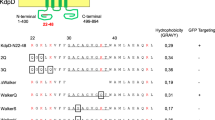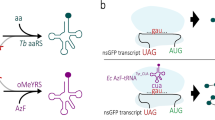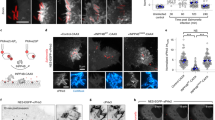Abstract
The src gene product, p60src, of Rous sarcoma virus (RSV) is a tyrosine-specific protein kinase which is associated with the plasma membrane of infected cells (for review, see ref. 1). Myristic acid is bound in an amide linkage to glycine 2 of p60src (refs 2–6). Of the N-terminal 30 kilodaltons of p60src only amino acids 1–14 are required for myristylation, and myristylation of p60src may be required for its membrane association, and for cell transformation4,7. To test the hypothesis that the first 14 amino acids of p60src contain a recognition sequence for myristylation, we have fused the DNA sequence coding for these amino acids to either the fps gene of the F36 derivative of Fujinami sarcoma virus (FSV)8,9, or to the chimpanzee α-globin gene10. We report here that although the fusion proteins were myristylated, the parental proteins were not, and unlike the non-myristylated F36 p91fps which was not bound to the plasma membrane, the myristylated fusion protein was bound, like p60src. We conclude that the first 14 amino acids of p60src contain a sequence which is sufficient for myristylation, and which may direct proteins to the plasma membrane.
This is a preview of subscription content, access via your institution
Access options
Subscribe to this journal
Receive 51 print issues and online access
$199.00 per year
only $3.90 per issue
Buy this article
- Purchase on Springer Link
- Instant access to full article PDF
Prices may be subject to local taxes which are calculated during checkout
Similar content being viewed by others
References
Krueger, J. G., Garber, E. A. & Goldberg, A. R. Curr. Topics Microbiol. Immun. 107, 51–124 (1983).
Sefton, B. M., Trowbridge, I. S., Cooper, J. A. & Scolnick, E. M. Cell 31, 465–474 (1982).
Garber, E. A., Krueger, J. G., Hanafusa, H. & Goldberg, A. R. Nature 302, 161–163 (1983).
Cross, F. R., Garber, E. A., Pellman, D. & Hanafusa, H. Molec. cell. Biol. 4, 1834–1842 (1984).
Buss, J. E. & Sefton, B. M. J. Virol. 53, 7–12 (1984).
Schultz, A. M., Henderson, L. E., Oroszlan, S., Garber, E. A. & Hanafusa, H. Science 227, 427–429 (1984).
Pellman, D., Garber, E. A., Cross, F. R. & Hanafusa, H. Proc. natn. Acad. Sci. U.S.A. (in the press).
Shibuya, M. & Hanafusa, H. Cell 30, 787–795 (1982).
Foster, D. A. & Hanafusa, H. J. Virol. 48, 744–751 (1983).
Liebhaber, S. A. & Begley, K. A. Nucleic Acids Res. 11, 8915–8929 (1983).
Feldman, R. A., Wang, E. & Hanafusa, H. J. Virol. 45, 782–791 (1983).
Woolford, J. & Beemon, K. Virology 135, 168–180 (1984).
Moss, P. et al. J. Virol. 52, 557–565 (1984).
Courtneidge, S. A., Levinson, A. D. & Bishop, J. M. Proc. natn. Acad. Sci. U.S.A. 77, 3783–3787 (1980).
Wold, F. A. Rev. Biochem. 50, 783–814 (1981).
Carr, S. A., Biemann, K., Shoji, S., Parmelee, D. C. & Titani, K. Proc. natn. Acad. Sci. U.S.A. 79, 6128–6131 (1982).
Aitken, A. et al. FEBS Lett. 150, 314–318 (1982).
Henderson, L. E., Krutzsch, H. C. & Oroszlan, S. Proc. natn. Acad. Sci. U.S.A. 80, 339–343 (1983).
Schultz, A. M. & Oroszlan, S. Virology 133, 431–437 (1984).
Willumsen, B. M., Christensen, A., Hubbert, N. L., Papageorge, A. G. & Lowy, D. R. Nature 310, 583–586 (1984).
Kreil, G. A. Rev. Biochem. 50, 317–348 (1981).
Schatz, G. & Butow, R. A. Cell 32, 316–318 (1983).
Hall, M. N., Hereford, L. & Herskowitz, I. Cell 36, 1057–1065 (1984).
Kalderon, D., Richardson, W. D., Markham, A. F. & Smith, A. E. Nature 311, 33–38 (1984).
Walter, P., Gilmore, R. & Blobel, G. Cell 38, 5–8 (1984).
Cross, F. R. & Hanafusa, H. Cell 34, 597–607 (1983).
Takeya, T. & Hanafusa, H. J. Virol. 44, 12–18 (1982).
Mathey-Prevot, B., Hanafusa, H. & Kawai, S. Cell 28, 897–906 (1982).
Author information
Authors and Affiliations
Rights and permissions
About this article
Cite this article
Pellman, D., Garber, E., Cross, F. et al. An N-terminal peptide from p60src can direct myristylation and plasma membrane localization when fused to heterologous proteins. Nature 314, 374–377 (1985). https://doi.org/10.1038/314374a0
Received:
Accepted:
Issue Date:
DOI: https://doi.org/10.1038/314374a0
This article is cited by
-
Chimeric VEGFRs are activated by a small-molecule dimerizer and mediate downstream signalling cascades in endothelial cells
Oncogene (2000)
-
Stimulus-dependent myristoylation of a major substrate for protein kinase C
Nature (1988)
-
Calcium, cyclic AMP and protein kinase C ? partners in mitogenesis
Cancer and Metastasis Review (1987)
Comments
By submitting a comment you agree to abide by our Terms and Community Guidelines. If you find something abusive or that does not comply with our terms or guidelines please flag it as inappropriate.



